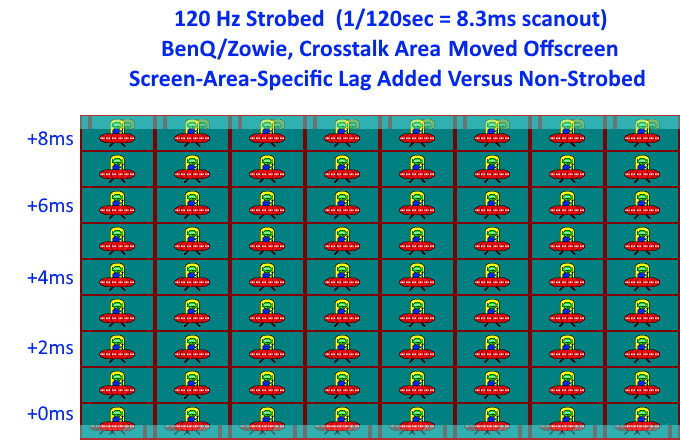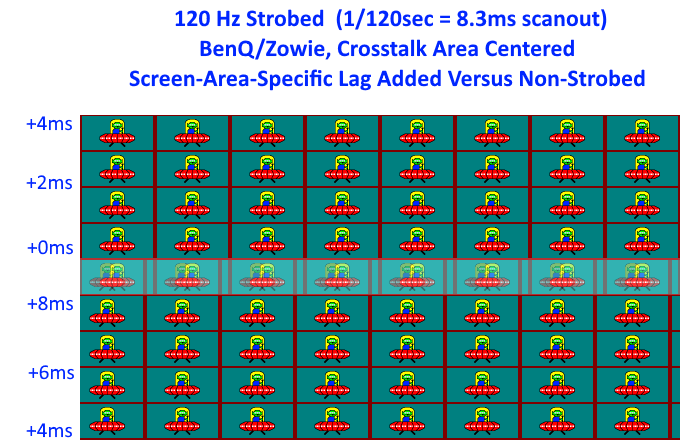Had some questions about the Area setting in the BenQ XL2540.
1920x1080 @240Hz
Which area setting has the least input lag? (I know awhile back that people suggested watching for a 1 pixel shift but my eyesight blows)
Which area setting has the least/most acceptable crosstalk?
XL2540 Blur Reduction Area Setting
-
Falkentyne
- Posts: 2795
- Joined: 26 Mar 2014, 07:23
Re: XL2540 Blur Reduction Area Setting
In the old Z series monitors, the HIGHEST possible area setting you could use (before the backlight shut off), or Area (Strobe Phase=100) gave the lowest input lag. I do not know if that applies to the newest ones or not.
- Chief Blur Buster
- Site Admin
- Posts: 11653
- Joined: 05 Dec 2013, 15:44
- Location: Toronto / Hamilton, Ontario, Canada
- Contact:
Re: XL2540 Blur Reduction Area Setting
It depends on what area of screen is your highest priority. Usually it is the screen centre, but it can be others.
Due to law of physics, it applies universally to all full strobe backlights (backlights that flash all at once). There is a area lag asymmetry that is produced from the panel's finite-speed refreshing (top-to-bottom scanout) and the backlight's instantaneous flashing. So it's easier to explain visually with two diagrams.


Summary:
-- Input lag is lowest right above the strobe crosstalk zone.
-- Input lag is highest right below the strobe crosstalk zone.
-- This applies to all of the world's strobe backlight technologies on panels that refresh top-to-bottom
Higher refresh rates reduce the lag spread of strobe backlights. At 240Hz, the spreads from lag asymmetries is only 4.1ms while at 120Hz, the spreads from lag asymmetries is 8.3ms. Thusly, for competitive gameplay, if you love strobe backlights, 240Hz strobing is preferred by competitive players -- e.g. LG 27GK750-B or BenQ XL2540/XL2546/XL2740 -- as of today, these are the four 240Hz monitors that are able to strobe at 240Hz.
Due to law of physics, it applies universally to all full strobe backlights (backlights that flash all at once). There is a area lag asymmetry that is produced from the panel's finite-speed refreshing (top-to-bottom scanout) and the backlight's instantaneous flashing. So it's easier to explain visually with two diagrams.


Summary:
-- Input lag is lowest right above the strobe crosstalk zone.
-- Input lag is highest right below the strobe crosstalk zone.
-- This applies to all of the world's strobe backlight technologies on panels that refresh top-to-bottom
Higher refresh rates reduce the lag spread of strobe backlights. At 240Hz, the spreads from lag asymmetries is only 4.1ms while at 120Hz, the spreads from lag asymmetries is 8.3ms. Thusly, for competitive gameplay, if you love strobe backlights, 240Hz strobing is preferred by competitive players -- e.g. LG 27GK750-B or BenQ XL2540/XL2546/XL2740 -- as of today, these are the four 240Hz monitors that are able to strobe at 240Hz.
Head of Blur Busters - BlurBusters.com | TestUFO.com | Follow @BlurBusters on Twitter


Forum Rules wrote: 1. Rule #1: Be Nice. This is published forum rule #1. Even To Newbies & People You Disagree With!
2. Please report rule violations If you see a post that violates forum rules, then report the post.
3. ALWAYS respect indie testers here. See how indies are bootstrapping Blur Busters research!
Re: XL2540 Blur Reduction Area Setting
I'd be looking for an area where the crosstalk area is just below center like this.Chief Blur Buster wrote:It depends on what area of screen is your highest priority. Usually it is the screen centre, but it can be others.
Due to law of physics, it applies universally to all full strobe backlights (backlights that flash all at once). There is a area lag asymmetry that is produced from the panel's finite-speed refreshing (top-to-bottom scanout) and the backlight's instantaneous flashing. So it's easier to explain visually with two diagrams.
https://www.blurbusters.com/wp-content/ ... screen.png
https://www.blurbusters.com/wp-content/ ... ntered.png
Summary:
-- Input lag is lowest right above the strobe crosstalk zone.
-- Input lag is highest right below the strobe crosstalk zone.
-- This applies to all of the world's strobe backlight technologies on panels that refresh top-to-bottom
Higher refresh rates reduce the lag spread of strobe backlights. At 240Hz, the spreads from lag asymmetries is only 4.1ms while at 120Hz, the spreads from lag asymmetries is 8.3ms. Thusly, for competitive gameplay, if you love strobe backlights, 240Hz strobing is preferred by competitive players -- e.g. LG 27GK750-B or BenQ XL2540/XL2546/XL2740 -- as of today, these are the four 240Hz monitors that are able to strobe at 240Hz.

^around the area I marked in green.
Not sure if their's a good way for me to tell myself. I tried for about 15minutes yesterday after looking at your pictures and trying the test, and got motion sick after trying several different area settings. kinda my fault since the ufos were still going across the screen while I was staring at the area value :/
I tried taking a picture to see if that would show it and either my phone camera isn't good enough or maybe you just don't see it in still frame pictures.
-edit-
after looking at all my pictures and especially the one where I accidentally used the flash on my camera I do see crosstalk, except it looks like the entire screen...

I believe this is Area = 100
- Chief Blur Buster
- Site Admin
- Posts: 11653
- Joined: 05 Dec 2013, 15:44
- Location: Toronto / Hamilton, Ontario, Canada
- Contact:
Re: XL2540 Blur Reduction Area Setting
Sometimes you can, but it depends on the camera.Comanglia wrote:I tried taking a picture to see if that would show it and either my phone camera isn't good enough or maybe you just don't see it in still frame pictures.
1. Turn off camera flash
2. Adjust exposure to less than 1 refresh cycle (e.g. 1/150sec exposure
3. Use global shutter rather than rolling-scan shutter, or use a rolling-scan shutter faster than a monitor refresh cycle
4. Maximize screen brightness.
5. Pre-focus your camera (pause the motion test, lock focus, resume motion test)
6. Take photo.
If your smartphone camera is low resolution, bring phone closer, hold camera portrait -- and/or take three photos (top, center, bottom)
Stationary photographs are okay for strobe crosstalk tests, as long as the camera's exposure captures only one strobe flash (i.e. one refresh cycle's strobe flash), and your camera sensor scan is not slower than the display's refresh rate.
One thing I notice is your camera sensor is slow-scanning (taking 1/60sec) so it's creating additional disjoints mid-refresh cycle as different parts of your photographs (vertically) is capturing a different strobe. So it's hard to pre-judge for your screen.Comanglia wrote:after looking at all my pictures and especially the one where I accidentally used the flash on my camera I do see crosstalk, except it looks like the entire screen...
Head of Blur Busters - BlurBusters.com | TestUFO.com | Follow @BlurBusters on Twitter


Forum Rules wrote: 1. Rule #1: Be Nice. This is published forum rule #1. Even To Newbies & People You Disagree With!
2. Please report rule violations If you see a post that violates forum rules, then report the post.
3. ALWAYS respect indie testers here. See how indies are bootstrapping Blur Busters research!
- Chief Blur Buster
- Site Admin
- Posts: 11653
- Joined: 05 Dec 2013, 15:44
- Location: Toronto / Hamilton, Ontario, Canada
- Contact:
Re: XL2540 Blur Reduction Area Setting
Yes, below center -- if you're prioritizing minimized input lag near crosshairs row.Comanglia wrote:I'd be looking for an area where the crosstalk area is just below center like this.
At 240Hz, the strobe lag average is only +2ms (4ms worst right below crosstalk bar, 0ms best right above crosstalk bar) so this is, to me, cherrypicking.
But it is a consideration for some eSports players who want to understand how strobing affect input lag.
Head of Blur Busters - BlurBusters.com | TestUFO.com | Follow @BlurBusters on Twitter


Forum Rules wrote: 1. Rule #1: Be Nice. This is published forum rule #1. Even To Newbies & People You Disagree With!
2. Please report rule violations If you see a post that violates forum rules, then report the post.
3. ALWAYS respect indie testers here. See how indies are bootstrapping Blur Busters research!
